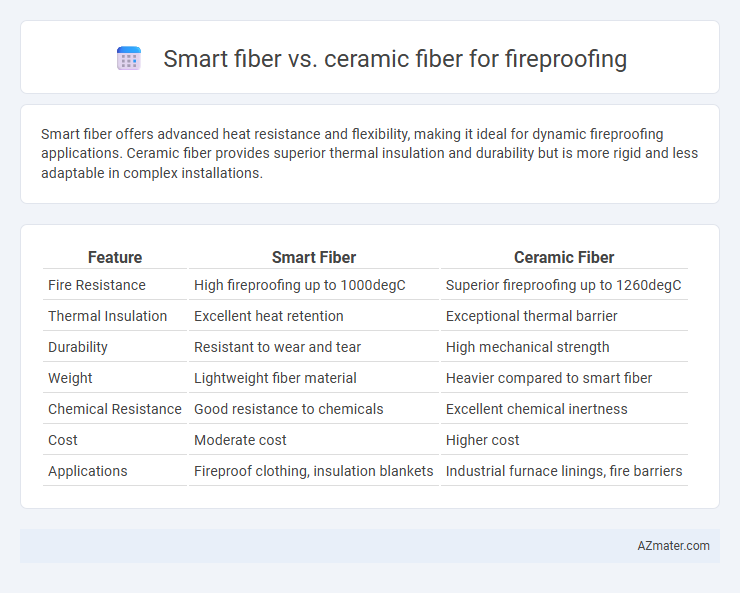Smart fiber offers advanced heat resistance and flexibility, making it ideal for dynamic fireproofing applications. Ceramic fiber provides superior thermal insulation and durability but is more rigid and less adaptable in complex installations.
Table of Comparison
| Feature | Smart Fiber | Ceramic Fiber |
|---|---|---|
| Fire Resistance | High fireproofing up to 1000degC | Superior fireproofing up to 1260degC |
| Thermal Insulation | Excellent heat retention | Exceptional thermal barrier |
| Durability | Resistant to wear and tear | High mechanical strength |
| Weight | Lightweight fiber material | Heavier compared to smart fiber |
| Chemical Resistance | Good resistance to chemicals | Excellent chemical inertness |
| Cost | Moderate cost | Higher cost |
| Applications | Fireproof clothing, insulation blankets | Industrial furnace linings, fire barriers |
Introduction to Fireproofing Materials
Smart fiber and ceramic fiber are essential fireproofing materials used in high-temperature insulation applications, offering distinct thermal properties and performance benefits. Smart fiber typically incorporates advanced polymer-based technologies designed for flexibility and enhanced thermal resistance, while ceramic fiber excels in withstanding extreme temperatures above 1000degC due to its inorganic composition and low thermal conductivity. Selecting the appropriate material depends on the specific fireproofing requirements, including temperature range, mechanical durability, and environmental exposure.
What are Smart Fibers?
Smart fibers are advanced materials designed to enhance fireproofing by responding dynamically to heat exposure, often by undergoing chemical or structural changes that improve insulation and flame resistance. Unlike traditional ceramic fibers, smart fibers can sense temperature changes and adapt their properties, offering improved durability and energy efficiency in fireproofing applications. These fibers are increasingly used in industrial insulation, aerospace, and construction for superior thermal management and safety.
Overview of Ceramic Fibers
Ceramic fibers are high-temperature insulating materials composed primarily of alumina and silica, known for their excellent thermal stability and resistance to chemical corrosion. These fibers can withstand temperatures up to 1,800degC, making them ideal for fireproofing applications in industrial furnaces and kilns. Their lightweight structure and low thermal conductivity provide superior fire retardant properties compared to traditional insulation materials.
Heat Resistance Comparison
Smart fiber offers superior heat resistance compared to ceramic fiber, withstanding temperatures up to 1200degC while maintaining structural integrity. Ceramic fiber typically endures up to 1000degC but can degrade faster under prolonged exposure to high temperatures. This makes smart fiber a more effective choice for fireproofing applications requiring enhanced thermal stability and durability.
Fire Protection Efficiency
Smart fiber offers superior fire protection efficiency compared to ceramic fiber due to its advanced heat resistance and rapid insulation properties, enabling faster thermal barrier activation during high-temperature exposure. Its enhanced thermal stability reduces heat transfer, minimizing structural damage and improving overall fire safety in industrial and commercial applications. Ceramic fiber provides effective insulation but typically exhibits slower response times and lower durability under sustained extreme heat conditions.
Durability and Lifespan
Smart fiber fireproofing materials exhibit enhanced durability due to their advanced polymer technology, offering superior resistance to wear, moisture, and thermal degradation compared to traditional ceramic fibers. Ceramic fiber, while highly heat resistant with melting points exceeding 1700degC, tends to suffer from brittleness and fiber degradation over time, reducing its effective lifespan in harsh environments. The lifespan of smart fiber solutions often surpasses ceramic fiber by 30-50%, making them a preferred choice for long-term fireproofing applications where durability and maintenance intervals are critical.
Installation and Maintenance
Smart fiber fireproofing offers faster installation due to its lightweight composition and flexible form, reducing labor time and complexity compared to ceramic fiber. Ceramic fiber requires precise handling and specialized tools for installation to avoid damage and maintain fire resistance, often leading to longer setup and higher maintenance costs. Maintenance for smart fiber is generally simpler as it resists cracking and degradation, whereas ceramic fiber demands frequent inspections and potential replacements to preserve its insulating properties.
Environmental and Health Considerations
Smart fiber fireproofing materials offer improved environmental benefits due to their biodegradable composition and lower release of harmful particulates during installation and exposure. Ceramic fiber, while effective in high-temperature resistance, often contains respirable crystalline silica, posing significant health risks such as respiratory diseases upon prolonged inhalation. Innovations in smart fiber technologies prioritize non-toxic, eco-friendly components, reducing environmental impact and enhancing worker safety in fireproofing applications.
Cost Analysis: Smart Fiber vs Ceramic Fiber
Smart fiber fireproofing offers higher initial costs compared to ceramic fiber but delivers enhanced durability and longer lifespan, reducing replacement expenses over time. Ceramic fiber provides a lower upfront cost, making it budget-friendly for short-term applications, yet it often requires more frequent maintenance and replacement. Evaluating total cost of ownership favors smart fiber for long-term fireproofing solutions, while ceramic fiber suits projects with limited budgets and shorter service requirements.
Which Fireproofing Material is Best?
Smart fiber offers enhanced thermal insulation and greater durability in fireproofing applications compared to ceramic fiber, which, while effective in high-temperature resistance, tends to be more brittle and less flexible. The advanced composition of smart fibers provides superior heat resistance, lower thermal conductivity, and improved structural integrity, making it ideal for environments requiring robust fire protection. For optimal fireproofing performance, smart fiber generally outperforms ceramic fiber due to its combination of strength, insulation efficiency, and long-term stability.

Infographic: Smart fiber vs Ceramic fiber for Fireproofing
 azmater.com
azmater.com